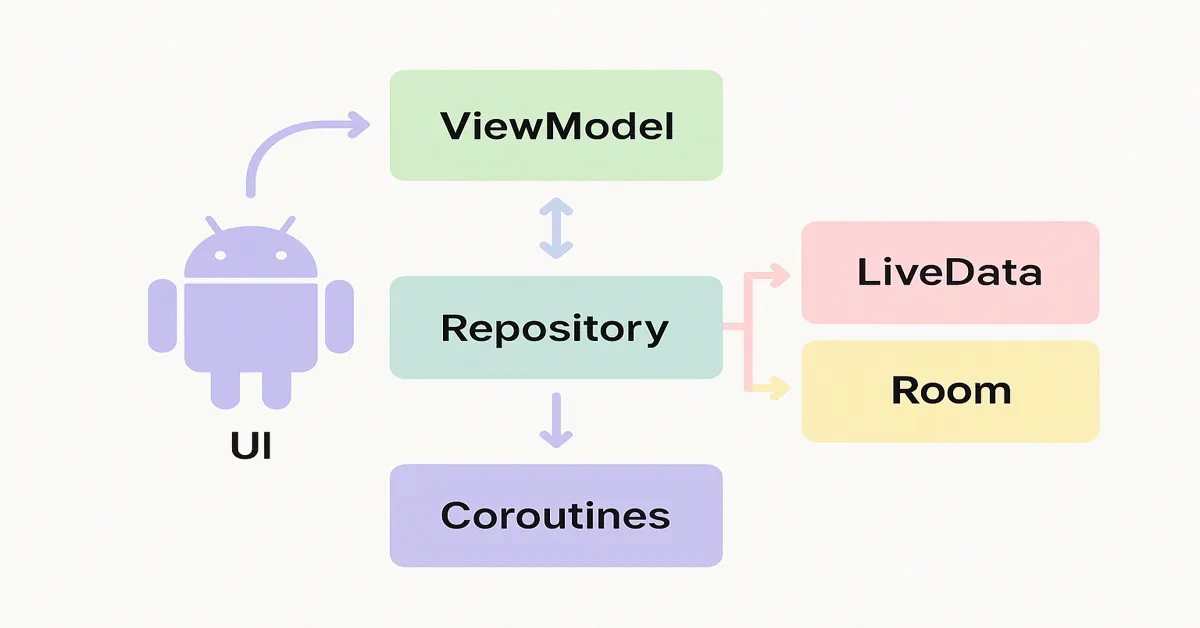In the ever-evolving world of Android development, architecture plays a pivotal role in building scalable, maintainable, and efficient mobile applications. As Kotlin becomes the language of choice and Jetpack components mature, a well-defined modern Android app architecture is no longer optional—it’s a necessity. In this article, we explore the foundational principles of modern Android development, focusing on Kotlin, Jetpack libraries, the MVVM pattern, and Coroutines for asynchronous programming.
A New Era in Android Development
Android development has undergone a significant transformation over the last decade. The earlier days of spaghetti code and tightly coupled components are gradually giving way to more modular, testable, and maintainable codebases. Kotlin’s rise has empowered developers with concise syntax, null safety, and functional programming paradigms. Meanwhile, Google’s Jetpack suite of libraries provides robust tools for UI, data persistence, and lifecycle management.
The Need for a Robust Architecture
The core purpose of an architecture is to provide a blueprint for the system, guiding decisions and ensuring clarity in communication among development teams. Without an architecture, applications often devolve into a tangled mess of interdependent classes, making maintenance, testing, and scaling a nightmare.
Characteristics of a Good Android Architecture:
- Separation of concerns: Clearly defined responsibilities for each component.
- Testability: Easier to write unit and integration tests.
- Scalability: Flexible to add new features without major refactoring.
- Reusability: Modular components that can be reused across applications.
- Maintainability: Code that’s easier to debug and evolve over time.
The Pillars of Modern Architecture
1. Kotlin: The Language of the Future
Since Google officially announced Kotlin as a first-class language for Android development in 2017, its adoption has skyrocketed. Kotlin is not just a syntactic sugar over Java. Its design is deeply aligned with the needs of modern mobile development.
Key Kotlin Features Beneficial for Architecture:
- Null Safety: Eliminates the billion-dollar mistake of null pointer exceptions.
- Extension Functions: Allows adding functionality to classes without modifying their code.
- Coroutines: Simplifies asynchronous programming and thread management.
- Immutability and Data Classes: Encourages a functional approach, reducing side effects.
2. Jetpack Libraries: The Backbone of Modern Apps
Jetpack is a suite of libraries that address common development challenges, helping developers follow best practices.
Notable Jetpack Components:
- LiveData: Lifecycle-aware observable data holder.
- ViewModel: Holds UI data and business logic while surviving configuration changes.
- Navigation Component: Simplifies navigation and deep linking.
- Room: ORM for SQLite databases, built with compile-time verification.
- WorkManager: Manages background tasks with system health in mind.
- Hilt: Jetpack’s recommended DI framework for Android.
Each of these components is designed to be lifecycle-aware, preventing memory leaks and reducing boilerplate code.
3. MVVM (Model-View-ViewModel): The Architectural Pattern
MVVM has become the de facto architectural pattern for Android applications. It promotes a clean separation between the UI and business logic, improving testability and scalability.
Components of MVVM:
- Model: Handles the data and business logic. Could involve Room, Retrofit, or local caches.
- ViewModel: Acts as a bridge between the Model and the View. Holds UI data and exposes LiveData or StateFlow.
- View: Typically an Activity or Fragment, it observes the ViewModel and reacts to UI updates.
Why MVVM?
- Eliminates tight coupling between View and Model.
- Makes unit testing of business logic simpler.
- Supports lifecycle-aware components naturally.
4. Coroutines: Modern Asynchronous Programming
Threading and asynchronous tasks are integral to mobile apps. Kotlin Coroutines offer a safer and more efficient alternative to traditional callbacks and thread management.
Key Concepts:
- Suspending Functions: Functions that can be paused and resumed without blocking a thread.
- CoroutineScope: Defines the lifecycle of coroutines.
- Dispatchers: Manage what thread or thread pool the coroutine runs on (Main, IO, Default).
- Structured Concurrency: Ensures that coroutines are canceled when no longer needed, avoiding memory leaks.
Putting It All Together: Building an Example App
Let’s walk through a conceptual example of a News app using modern Android architecture.
App Requirements:
- Fetch and display a list of articles from a REST API.
- Display article details on a new screen.
- Store user favorites in a local database.
- Update the UI reactively and handle background tasks efficiently.
1. Project Setup
Use Android Studio Arctic Fox or later. Enable Jetpack components and Kotlin support.
plugins {
id 'com.android.application'
id 'kotlin-android'
id 'kotlin-kapt'
id 'dagger.hilt.android.plugin'
}2. Define Data Layer
data class Article(
val id: Int,
val title: String,
val content: String,
val isFavorite: Boolean = false
)Retrofit API Interface
interface NewsApiService {
@GET("articles")
suspend fun getArticles(): List<Article>
}Room DAO
@Dao
interface ArticleDao {
@Query("SELECT * FROM article")
fun getAllArticles(): Flow<List<Article>>
@Insert(onConflict = OnConflictStrategy.REPLACE)
suspend fun insertArticles(articles: List<Article>)
}3. Repository
class NewsRepository @Inject constructor(
private val apiService: NewsApiService,
private val articleDao: ArticleDao
) {
fun getArticles(): Flow<List<Article>> = articleDao.getAllArticles()
suspend fun refreshArticles() {
val articles = apiService.getArticles()
articleDao.insertArticles(articles)
}
}4. ViewModel
@HiltViewModel
class NewsViewModel @Inject constructor(
private val repository: NewsRepository
): ViewModel() {
val articles: LiveData<List<Article>> = repository.getArticles()
.asLiveData()
fun refresh() {
viewModelScope.launch {
repository.refreshArticles()
}
}
}5. UI Layer
@AndroidEntryPoint
class NewsFragment : Fragment() {
private val viewModel: NewsViewModel by viewModels()
override fun onViewCreated(view: View, savedInstanceState: Bundle?) {
super.onViewCreated(view, savedInstanceState)
val adapter = ArticleAdapter()
recyclerView.adapter = adapter
viewModel.articles.observe(viewLifecycleOwner) {
adapter.submitList(it)
}
swipeRefreshLayout.setOnRefreshListener {
viewModel.refresh()
}
}
}Best Practices in Modern Android Architecture
1. Keep UI Logic Out of Views
Views should be as passive as possible. Avoid direct manipulation of data or complex logic in Activities and Fragments.
2. Prefer StateFlow or LiveData
Use reactive paradigms to drive UI updates. This minimizes errors and improves clarity.
3. Use Dependency Injection (Hilt)
Injecting dependencies via Hilt reduces boilerplate and encourages testable, modular design.
4. Modularize the Codebase
Separate features, core utilities, and data into distinct modules. This improves build times and scalability.
5. Write Tests
Use JUnit and MockK for unit testing, and Espresso or UI Automator for integration testing.
Challenges and Considerations
While modern Android architecture improves many aspects of app development, it comes with its own challenges:
- Learning Curve: Developers must be familiar with multiple tools and concepts.
- Tooling and Build Overhead: Hilt, Gradle, and annotation processors can slow build times.
- Balance: Overengineering small apps can be counterproductive.
Conclusion
Modern Android app architecture is not a rigid set of rules but a collection of best practices tailored to improve developer productivity and application quality. By embracing Kotlin, Jetpack, MVVM, and Coroutines, developers can build resilient, performant, and scalable Android applications. The key is to adapt the architecture to the problem at hand, focusing on clean code, modularity, and testability.
As Android continues to evolve, so too will its architectural paradigms. Staying updated, experimenting thoughtfully, and continually refactoring toward better patterns are the hallmarks of a proficient Android developer.
Read:
FAQs
1. What is the benefit of using MVVM architecture in Android apps?
MVVM (Model-View-ViewModel) separates concerns by isolating business logic from UI elements. This results in a more maintainable, testable, and scalable codebase. It also facilitates reactive programming through LiveData or StateFlow, allowing UI updates to occur automatically in response to data changes.
2. Why are Kotlin Coroutines preferred over traditional callbacks or RxJava?
Kotlin Coroutines provide a simpler and more structured way to handle asynchronous operations without nesting callbacks or managing disposable streams. They improve readability, reduce boilerplate, and offer features like structured concurrency and automatic cancellation tied to lifecycle scopes.
3. What is the role of Jetpack libraries in modern Android development?
Jetpack libraries provide a set of components that help manage UI, data persistence, lifecycle, navigation, and background tasks in a lifecycle-aware, modular, and efficient manner. They are designed to integrate seamlessly with Kotlin and modern architecture patterns like MVVM.
4. How does Hilt help with Dependency Injection in Android apps?
Hilt simplifies dependency injection in Android by reducing boilerplate code and managing the lifecycle of dependencies automatically. It integrates with Jetpack components and supports scopes like ViewModel, Activity, and Application, enabling modular and testable architecture.
5. When should I choose to modularize my Android app architecture?
Modularization is ideal for large projects or teams working on multiple features. It helps in reducing build times, improves code organization, allows feature isolation, and supports better testability and scalability. Start modularizing once your app’s complexity or team size begins to grow.











